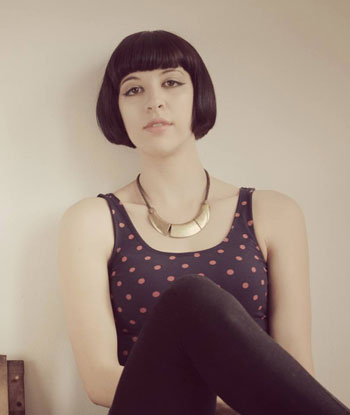November 26, 2014
Interview with Robin Richardson
 Robin Richardson’s poem, “Vlad the Uninspired,” appears in Fjords Review, Volume 2, Issue 2.
Robin Richardson’s poem, “Vlad the Uninspired,” appears in Fjords Review, Volume 2, Issue 2.
About Robin Richardson
 Seth Clabough is the author of Knife Throwing Through Self-Hypnosis (ECW Press, 2013) and Grunt of the Minotaur (Insomniac Press, 2011). Her work has been shortlisted for the CBC Poetry Award and has won the John B. Santoianni Award (awarded by The Academy of American Poets) and the Joan t. Baldwin Award. She holds an MFA in poetry from Sarah Lawrence, and divides her time between Toronto and New York.
Seth Clabough is the author of Knife Throwing Through Self-Hypnosis (ECW Press, 2013) and Grunt of the Minotaur (Insomniac Press, 2011). Her work has been shortlisted for the CBC Poetry Award and has won the John B. Santoianni Award (awarded by The Academy of American Poets) and the Joan t. Baldwin Award. She holds an MFA in poetry from Sarah Lawrence, and divides her time between Toronto and New York.
1. What inspired your piece, ”Vlad the Uninspired”?
RR: When I was eighteen I took a year off school, saved up a modest sum of money, and set out to Europe to see a bit of the world before I settled back into academia. I started off in Spain, spent some time in Vienna, and Prague. Then, towards the end of my trip, I was joined by my off-and-on boyfriend (mainly off by then). I remember we were sitting in a bus station in Spain in the middle of the night, trying to decide where to go next, neither of us had much money left, so it had to be some place cheap. We scanned the departure times and suddenly, at the sight of Bucharest, Romania, he perked up, ”let’s go there!” I agreed for two reasons: Firstly because my dyslexic self had confused Bucharest with Budapest, and secondly the arrival time was 6:00 am, a little less than twenty-four hours. This, at my age, was manageable. I was wrong on both counts. Bucharest is no Budapest, and 6:00 am did not mean the following day, but rather two days later. I spent forty hours on a cramped bus while ABBA played on repeat over the speakers, only to arrive in the place where there were more stray dogs than humans, and the manholes had no covers.
What struck me most about the landscape was how at home my ex had seemed there. He reveled in the grey, the poverty; he felt his own somber disposition had found a home. The poem is primarily about what it was like to witness him in that environment.
Vlad is Vlad Tepes, or Vlad the Impaler: a brutal ruler in Bucharest in the fourteen hundreds who was in many ways the precursor to Dracula. How could I not bring him into the poem?
2. Name a place you’ve written about but never been to.
RR: Kentucky, Texas, Hades, Yellowstone, outer space, inside other people’s heads.
3. What is the easiest part of writing?
RR: The fact that I unconditionally love it; love makes even the most daunting tasks are made easy. Specifically when it comes to process, I enjoy most those moments when, poised in the commencement of a poem, I reach a sort of trance—pillaging my brain for the artifacts that belong, setting those artifacts into the right words, right order—bringing it all together into something that feels, eventually, like harmony.
What I find most difficult about poetry is finished work. Process is where the love is; once a poem is published and out of my hands, I view it with a degree of mistrust... like a mother forced to accept that her child is beyond her influence, and likely up to no good.
4. What’s the loveliest thing you’ve ever seen?
RR: What a beautiful question. I’m going to take some liberty here and make a list; naming just one seems insufficient, and besides, lists are fun to make.
* Bright, white, low-hanging clouds over the East River.
* Micaela dancing in her living room like an unabashed child to Rihanna’s Diamonds.
* Those YouTube compilations of soldiers reuniting with their families.
* The film Besieged. If you haven’t seen it, do. A beautiful idea.
* Otters playing.
* My grandparents holding hands, silly smiles on their faces.
There are a thousand others I’m sure, but you get the idea.
5. If you could pair your piece, “Abandoned Mannequin Plant,” with any piece of artwork, what would you choose?
RR: It’s funny you ask that because the poem itself is inspired by the Disney film Pinocchio. I have a habit of personifying inanimate objects, even feeling deeply for them—a and so the idea of a soul trapped in an inanimate object is powerfully moving to me. Another, more recent, artwork that might fit (also a movie, and along the same theme) is Spike Jonze’s Her. I sat in the theater bawling my eyes out as Samantha (an operating system) pined for a physical humanity she would never attain.
6. What has lasted you ten years?
RR: My brown leather wallet, my best friend, my love of poetry, the nagging knowledge that there are always more and better things to read and learn and create.
7. What are you currently working on?
RR: I’m working on my third collection of poems, tentatively titled, Saturnalia. I'm also writing and illustrating a children’s book about an earthworm and the little girl who took him for granted. I’d love to write articles and essays about poetry, the arts, life, and human interaction... so if anyone’s hiring, let me know!

